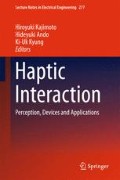Abstract
We developed a prototype of an exoskeletal patient simulator that allows clinical trainees to experience and learn about ankle disorders related to hemiplegia. The exoskeleton exerts abnormal joint torques by tendon mechanisms while realizing complex ankle movements and realistic bone and skin features. Using this exoskeleton, we simulated the resistances of spasticity and clonus, which are typical symptoms of hemiplegia. We demonstrated these two types of simulated symptoms and showed their validity.
Access this chapter
Tax calculation will be finalised at checkout
Purchases are for personal use only
References
Dietz, V., Sinkjaer, T.: Spastic movement disorder: impaired reflex function and altered muscle mechanics. Lancet Neurol. 6, 725–733 (2007)
Galota, A., Feldman, A.G., Levin, M.F.: Spasticity measurement based on tonic stretch reflex threshold in stroke using a portable device. Clin. Neurophysiol. 119(10), 2329–2337 (2008)
Grow, D.I., Wu, M., Locastro, M.J., Arora, S.K., Bastian, A.J., Okamura, A.M.: Haptic simulation of elbow joint spasticity. In: Proceedings of IEEE Symposium on Haptic Interfaces for Virtual Environments and Teleoperator Systems, pp. 475–476 (2008)
Hidler, J.M., Rymer, W.Z.: A simulation study of reflex instability in spasticity: origins of clonus. IEEE Trans. Rehabil. Eng. 7(3), 327–340 (1999)
Ishikawa, S., Okamoto, S., Akiyama, Y., Isogai, K., Yamada, Y., Hara, S.: Wearable dummy to simulate joint impairment: model for the discontinuous friction resistance due to arthritis. In: Proceedings of IEEE International Conference on Robotics and Biomimetics, pp. 1409–1414 (2012)
Ishikawa, S., Okamoto, S., Isogai, K., Akiyama, Y., Yanagihara, N., Yamada, Y.: Wearable dummy to simulate joint impairment: severity-based assessment of simulated spasticity of knee joint. In: Proceedings of the IEEE/SICE International Symposium on System Integration, pp. 300–305 (2013)
Kikuchi, T., Oda, K., Furusho, J.: Leg-robot for demonstration of spastic movements of brain-injured patients with compact magnetorheological uid clutch. Adv. Rob. 24, 671–686 (2010)
Kikuchi, T., Oda, K., Yamaguchi, S., Furusho, J.: Leg-robot with MR clutch to realize virtual spastic movements. J. Intell. Mater. Syst. Struct. 21, 1523–1529 (2010)
Okumura, H., Okamoto, S., Ishikawa, S., Akiyama, Y., Isogai, K., Hirano, Y., Yamada, Y.: Wearable dummy to simulate equinovarus for training of physical therapists. In: Proceedings of SICE Annual Conference, pp. 2272–2277 (2013)
Park, H.S., Kim, J., Damiano, D.L.: Development of a haptic elbow spasticity simulator(HESS) for improving accuracy and reliability of clinical assessment of spasticity. IEEE Trans. Neural Syst. Rehabil. Eng. 20, 361–370 (2012)
Acknowledgment
This work was in part supported by Naito Foundation.
Author information
Authors and Affiliations
Corresponding author
Editor information
Editors and Affiliations
Rights and permissions
Copyright information
© 2015 Springer Japan
About this chapter
Cite this chapter
Okumura, H. et al. (2015). Exoskeleton Simulator of Impaired Ankle: Simulation of Spasticity and Clonus. In: Kajimoto, H., Ando, H., Kyung, KU. (eds) Haptic Interaction. Lecture Notes in Electrical Engineering, vol 277. Springer, Tokyo. https://doi.org/10.1007/978-4-431-55690-9_40
Download citation
DOI: https://doi.org/10.1007/978-4-431-55690-9_40
Published:
Publisher Name: Springer, Tokyo
Print ISBN: 978-4-431-55689-3
Online ISBN: 978-4-431-55690-9
eBook Packages: EngineeringEngineering (R0)

